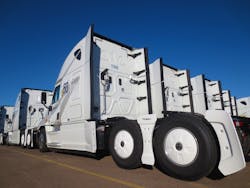Swift Transportation deploys FlowBelow Tractor Aerokit
FlowBelow Aero Inc., a leading manufacturer of tractor-mounted aerodynamic products, announced that Swift Transportation Company will begin deploying thousands of FlowBelow Tractor AeroKit systems in its fleet immediately.
Swift Transportation is North America’s largest full-truckload (FTL) carrier, operating over 18,000 trucks throughout the United States, Canada and Mexico, and logging more than a billion miles per year. The company is an EPA SmartWay Charter Partner and has built a reputation for achieving optimal efficiency in every way that is both practical and economical.
“Here at Swift we are laser focused on implementing new technologies that are economical and proven to improve safety, fuel efficiency, and driver comfort,” said Bert Kinsel, VP of Heavy Equipment Procurement, Swift Transportation. “Over the years, we have refined the specs of our trucks and trailers to optimize the air flowing around the vehicle and reduce drag as much as possible. Many aerodynamic products for trailers exist today, and we certainly utilize those that work well for us. But because we operate over three trailers for every one truck in the fleet, meaning that our trailers are utilized approximately one-third as much as the tractors, the return on an investment for a trailer-mounted technology can take a lot longer than a comparable technology installed on one of our trucks. FlowBelow’s system only needs to be installed on the tractor. The best thing about it is that it makes an impact on every mile we drive.”
The FlowBelow Tractor AeroKit reduces aerodynamic turbulence and drag around the rotating wheels of the truck. The system includes four quick-release wheel covers as well as four fairings strategically placed between and behind the drive wheels of the truck. For trucks traveling above 40 MPH, the system is highly effective at reducing drag. Lower drag means less horsepower is required to move the vehicle, which results in improved fuel efficiency. Citing multiple third party tests, FlowBelow claims the Tractor AeroKit is verified to provide up to a 2.23 percent fuel savings.
Swift first began testing the Tractor AeroKit in 2014 and employs an extensive evaluation process when considering the implementation of a new technology. After completing initial SAE fuel efficiency tests against a control vehicle, Swift deployed 100 AeroKits into the fleet for nine months to further test the product’s durability, ease of use and real-world fleet average fuel efficiency performance. The initial large-scale deployment of the Tractor AeroKit through 2017 is expected to account for approximately 40 percent of Swift’s company trucks.
According to FlowBelow CEO, Josh Butler, “It is truly amazing when you consider how much fuel is consumed by trucks today. A countless number of engineers and entrepreneurs are working tirelessly to bring new ideas into practice in order to improve fuel efficiency and reduce emissions from heavy vehicles. By working with Swift, the largest truckload carrier in the nation, we are putting some of those countless engineering hours into practice and making a major impact in the process.”
Each AeroKit includes four quick-release wheel covers, which provide instantaneous access to the wheel end via FlowBelow’s patented ‘push and turn’ quick-release latching system. The AeroKit is complementary to other aerodynamic devices installed on the trailer, allowing a fleet to capture all available fuel savings from aerodynamic improvements across the entire vehicle.
The FlowBelow Tractor AeroKit was first introduced in 2013, and is now available as a factory-installed option on certain new model trucks. FlowBelow confirmed that customers ordering new Freightliner or Kenworth trucks from their dealers throughout North America can spec the truck with the system to have it financed with the equipment and installed prior to taking delivery. Some fleets, such as MVT, Hirschbach and others have deployed the FlowBelow system via a full fleet retrofit program. Today, retrofit applications account for over half of FlowBelow’s business. The system can be installed in as little as one hour for retrofits.


